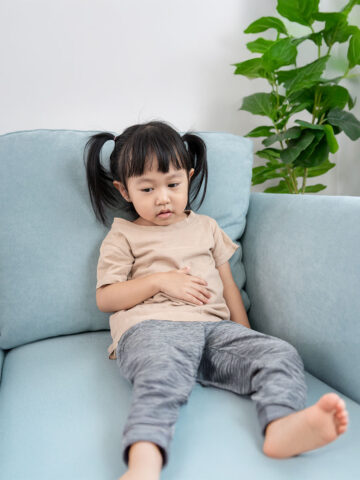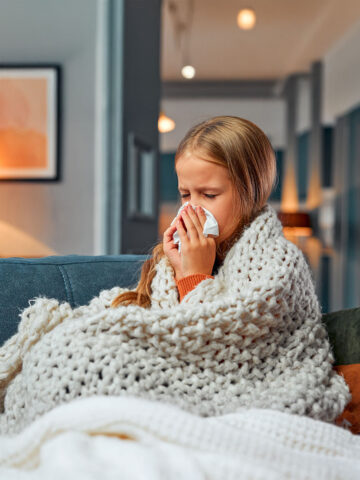What happens when baby starts teething?
Teething signs and symptoms vary among each baby, but parents can expect to see more drool and a desire to chew on objects, says Dr. Lori Openshaw a pediatrician in the CHOC Primary Care Network.
Discomfort, rosy cheeks, and excessive drool which can irritate the skin causing facial rashes, as well as loose stools can appear during this time, she says.
Some babies may not experience any pain, but others may have periods of pain and irritability. Some babies might be briefly unhappy, but others might seem to be cranky for weeks, with crying spells and disrupted sleeping and eating patterns. While teething can be uncomfortable, parents should call their pediatrician if their baby seems overly fussy, Dr. Openshaw says.
A teething baby’s temperature may rise slightly at this time due to tender and swollen gums, but teething doesn’t typically prompt a high fever or diarrhea. A fever at this time is likely caused by something different, and a call to the pediatrician is warranted, advises Dr. Openshaw.
When does teething time start? At what age does baby get their first tooth?
Baby teething age can vary, but most babies begin teething between ages 4 and 7 months. Early teething can begin in some babies as young as 3 months, and teething can begin as late as 12 to 14 months.
When and how teeth come in is different for every baby and may follow a timeline seen in their family history. Most of the time, a parent or caregiver will see the two front bottom teeth come in first, followed by the four front upper teeth, then the lower teeth on either side of the front lower teeth. Molars, the back teeth used to grind food, will break through next, followed by the canines. This period is sometimes called the “2-year-old molars.”
Most children have all 20 primary teeth by their third birthday.
How can I help a baby who is uncomfortable from teething?
Teething can be uncomfortable for babies – and thus, for parents too. Dr. Openshaw offers these tips to help make the transition easier:
- Gently wipe the baby’s face often with a cloth to remove drool and prevent rashes.
- Use a clean finger or wet washcloth wrapped around your finger to rub the baby’s gums.
- Teething rings or a baby-safe teething feeder may be used with ice or cold food for baby to gnaw on safely
- A simple teething aid is a wet washcloth placed in the freezer for 30 minutes. Just be sure to remove it from the freezer before it becomes too hard and wash it after each use.
- Chilling teething rings in the freezer or refrigerator can be helpful, however it is best to avoid products with liquids inside because they might break or leak. Also, avoid boiling rings to sterilize them because the high temperatures could damage the plastic and cause chemicals to leak.
- Give babies who are already eating solid foods cold foods in a baby-safe feeder, such as one made of mesh or silicone.
- Speak to a pediatrician about giving babies ages 6 months or older acetaminophen or ibuprofen to help with pain. This can be done on rare occasions but should not be given routinely.
Here are some things Dr. Openshaw advises parents not do when their baby is teething:
- Don’t use teething necklaces especially with small items such as amber. These can lead to strangulation and can also cause choking if pieces break.
- Don’t tie a teething ring around a baby’s neck or any other body part because it can lead to strangulation.
- Don’t use teething gels or tablets unless directed by your doctor because they may not be safe for babies.
- Never place an aspirin or any tablets against an emerging tooth or in baby’s mouth and do not rub alcohol on the baby’s gums.
How should I care for my baby’s teeth?
Even before teeth emerge, parents can practice daily dental care with their baby. This is not necessary, however it can help prepare sensitive babies for having their mouths and gums touched during brushing when teeth do arrive and need brushing. To do this, just wipe a baby’s gums with a clean, damp washcloth on a daily or twice-daily basis.
Once the first tooth emerges, it’s time to start daily brushing with a tiny smear (the size of grain of rice) of fluoridated toothpaste. Even though the baby teeth will ultimately fall out to make way for adult teeth, caring for baby teeth is important for long-term dental health. In addition to starting important habits, daily brushing prevents decay in baby teeth, which would make them fall out more quickly and lead to crooked and crowded adult teeth.
An important thing to know about tooth care is that babies should never fall asleep with a bottle of milk or juice. Milk or juice can pool in baby’s mouth and cause tooth decay, something called baby bottle tooth decay, Dr. Openshaw cautions. It can also lead to increased childhood ear infections.
By the time all baby teeth have emerged, parents should try to brush them at least twice a day and especially after meals. Once teeth start to touch, it’s time to start flossing.
When children are older – about age 3 – it’s OK to use a pea-sized amount of fluoridated toothpaste. Ensure the child spits out the toothpaste, as too much fluoride can be harmful.
The American Dental Association (ADA) recommends that children begin seeing a dentist by age 1, or within six months of a tooth’s first appearance.
For more health and wellness resources from the pediatric experts at CHOC, sign up for the Kids Health newsletter.
Find a CHOC Primary Care Pediatrician
From babies to teens, pediatricians from CHOC’s Primary Care Network partner with parents to offer immunizations, sick visits, sports physicals and more.





